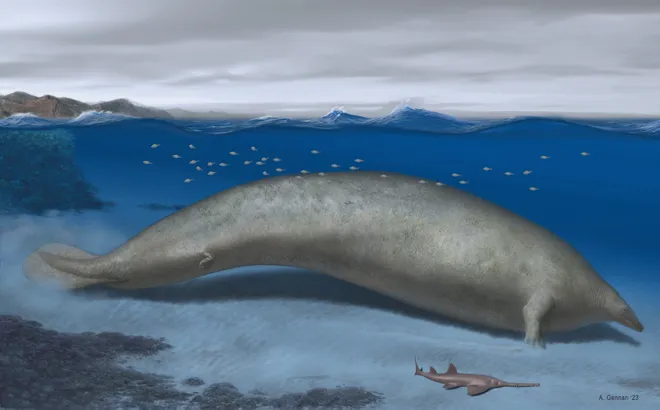Biggest animal ever? Scientists say they've discovered a massive and ancient whale.
Move over, blue whale. You've been demoted.
Scientists have discovered what they say could be the heaviest animal that ever lived on Earth: a gigantic ancient whale that may have been two to three times as heavy as the modern blue whale.
The newly discovered whale, which has been given the Latin name Perucetus colossus (“the colossal whale from Peru”), lived about 39 million years ago.
Though its roughly 66-foot length doesn't break records, its weight does. The study estimates it weighed 375 tons − or about as heavy as 35 school buses.
Blue whales are still historically large animals: Some can grow to more than 100 feet.
Perucetus colossus was “possibly the heaviest animal ever,” said study co-author Alberto Collareta, a paleontologist at Italy’s University of Pisa. But “it was most likely not the longest animal ever.”
A portion of the whale's skeleton was discovered recently in southern Peru, according to the study published Wednesday in the British journal Nature.
"This finding challenges our understanding of body-size evolution," J. G. M. Thewissen and David A. Waugh write in a companion article. In fact, the findings suggest that the trend toward gigantism in marine mammals may have begun earlier than thought, according to the study.

Discovery sheds new light on largest known animals on Earth
Whales, dolphins and porpoises belong to a group called cetaceans, which includes the largest known animals that ever lived, the two scientists write. Until now it had been assumed that the blue whale holds the record for the largest body size.
But "the estimated skeletal mass of P. colossus exceeds that of any known mammal or aquatic vertebrate," the authors write in the study. It was led by Eli Amson, a paleontologist at the State Museum of Natural History in Stuttgart, Germany.
The whale is modeled from a partial skeleton, which includes 13 vertebrae, four ribs and one hip bone. Each vertebra weighs more than 220 pounds, and its ribs measure nearly 5 feet long.
The massive fossils “are unlike anything I’ve ever seen,” Collareta said.
According to the study, the whale is a member of the basilosaurid group, a family of extinct cetaceans. It not only was extremely large, but it also had an exceptionally heavy skeleton relative to its body mass. "It substantially pushes the upper limit of skeletal mass in mammals, as well as in aquatic vertebrates in general," the study says.
The animal was a slow swimmer that probably lived close to the coast and fed near the bottom of the sea.
'A previously unknown life form'
The findings show cetaceans had reached peak body mass an estimated 30 million years before it had been assumed. The features of P. colossus were fully adapted to an aquatic environment.
Further research is needed to answer more questions about the animal and how it lived. As Thewissen and Waugh note, "the importance of this fossil goes beyond the documentation of a previously unknown life form."
Contributing: The Associated Press
Disclaimer: The copyright of this article belongs to the original author. Reposting this article is solely for the purpose of information dissemination and does not constitute any investment advice. If there is any infringement, please contact us immediately. We will make corrections or deletions as necessary. Thank you.


